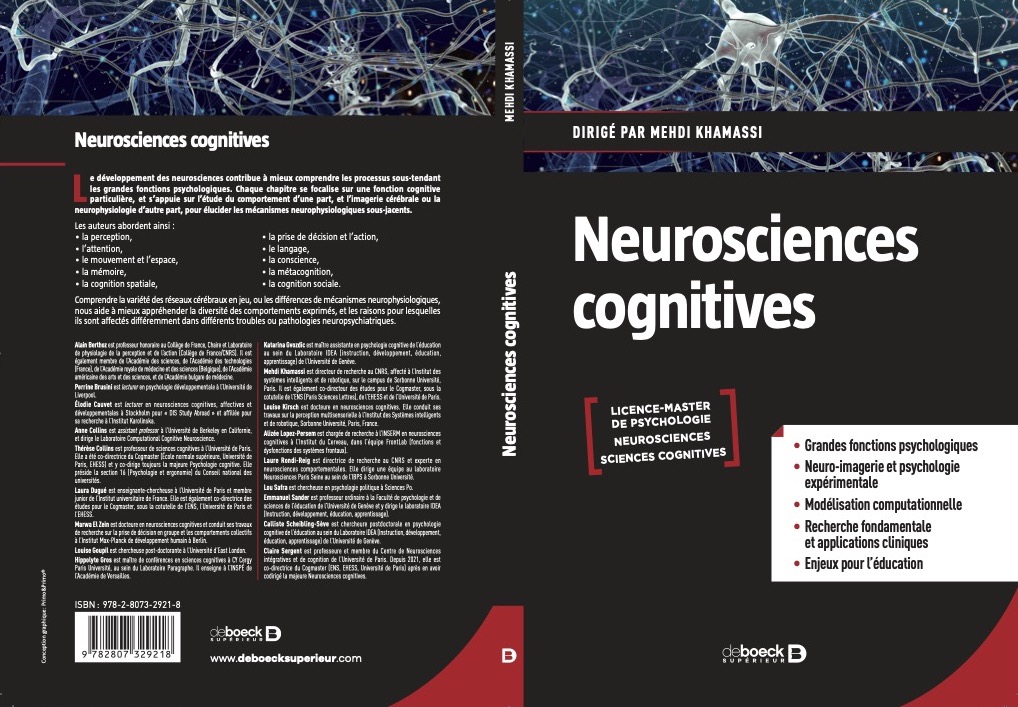The development of neuroscience is contributing to a better understanding of the processes that underlie the major psychological functions. Understanding the variety of brain networks or differences in neurophysiological mechanisms helps to better understand the diversity of behaviours expressed.
Mehdi Khamassi, research director at the CNRS, conducts his research activities at the interface between neuroscience and robotics. The main objective of his research is to understand which learning mechanisms can allow autonomous agents to show behavioural flexibility and adaptation capacities in their partially unknown and changing environment.
His book on cognitive neuroscience provides an introduction to current research at the interface between psychology, neuroscience and modelling.
How is doing neuroscience at ISIR different from doing it in an experimental neuroscience laboratory?
The big difference is that we are not immersed in the day-to-day environment where neurobiological experiments are carried out on humans or animals, but rather in the environment where theoretical aspects are discussed and where experiments are carried out on robots.
This is complementary to what is done in other laboratories. It allows us to step back from the data and take a broader view, better anchored in theory. For example, by asking from a normative point of view what calculations an agent should try to make so that its behaviour is the most adapted to the variety of environments to which it is exposed. Having found an answer to this question on the theoretical side, one can return to the experimental data. We can try to make sense of it by looking at whether the brain seems to perform some of these calculations in a way that is not necessarily specific to the experimental task, but more general. In this sense, we can sometimes find explanations for measured brain activities or experimentally observed behaviours that do not seem to be optimal or rational in relation to the task at hand, but in fact turn out to be adapted to the variety of situations that the agent is confronted with in his or her life.
At the opposite extreme, one should be careful not to be too far from the data! I always think it is good to have seen human/animal behaviour up close and what brain activity recorded in the laboratory looks like in order to be able to design relevant computational models. I myself have worked for several years in experimental neuroscience laboratories in the past. And in the AMAC team at ISIR we continue to have frequent exchanges with experimentalists to (1) design new experiments to test the predictions of the models, and (2) to confront the data collected with these same models.
In return, working in a robotics and Artificial Intelligence lab on a daily basis can inform colleagues in these fields about what is known about how the brain works, in the hope that this can be a fertile source of inspiration and biomimicry.
How has working at ISIR shaped your perspective and influenced the content of your book?
Working at ISIR has helped shape the way I approach cognition. Being immersed in a laboratory that does research in robotics or Artificial Intelligence allows you to feed off the advances in these fields. These are sources of inspiration that can help enrich models for neuroscience and psychology.
Indeed, when we look at how to enable a robot to autonomously choose its actions and learn from the consequences of its actions, we sometimes find solutions that help us to better understand the nature of the neural mechanisms that underlie similar problems in the biological brain.
It can also be mentioned that robotics forces us to think about the role of the body in cognition, not just how disembodied artificial intelligence programs should solve the problems the robot faces. Like the dynamic passive walkers developed in the 1990s at Cornell University, which produce a fluid walking motion by the simple dynamics of the robot’s mechanical joints, without any algorithmic control.
Robotics also forces us to think about how to make different cognitive functions (perception, decision, movement, learning, etc.) communicate in the same architecture, in the same agent. This forces us to take into account the interactions between different mechanisms supposedly involving different brain areas, and to formulate new hypotheses on these interactions.
For all these reasons, I think that ISIR has contributed to my vision of cognition being at a very systemic level. It is a vision very close to that of the cognitive sciences. That’s why my book deals with issues of perception and movement, social and non-social cognition, language and action, decision and meta-cognition, memory and consciousness.
One of the original features of the book is the introduction to computational modelling, with associated open source code. Modelling for neuroscience and psychology has recently gained a lot of momentum, and still appears only too rarely in existing textbooks on cognitive neuroscience.
“Cognitive Neuroscience”, by Mehdi Khamassi
On October 12, 2021, de Boeck Supérieur Editions will publish a book entitled “Cognitive Neurosciences”, edited by Mehdi Khamassi, which provides an introduction to current research at the interface between psychology and neuroscience.

The field of psychology has expanded and diversified incredibly since cognitive science first appeared, to the point where it is difficult for students to find their way through the many disciplines. What is the relationship between psychological processes and neural networks? How do neurological underpinnings translate into the psychology of individuals? This book answers these questions, organised according to the main psychological functions: action, attention, language, memory and perception, their neurobiological bases, their pathological dysfunctions and their therapeutic remediation.
While many French-speaking university textbooks are monodisciplinary, introducing either neuroscience or psychology in general, this book aims to highlight how the two disciplines have fed off each other to address major cognitive functions such as perception, attention, movement and space, memory, spatial cognition, decision-making and action, language, consciousness, metacognition or social cognition.
The book is primarily intended for undergraduate and graduate students of psychology and neuroscience who want to combine the two disciplines or are interested in their articulation. It is also intended for those who wish to learn about computational modelling for these two disciplines. But the chapters are written in a way that is accessible enough for any non-specialist interested in neuroscience and cognition to refer to them and find elements of initiation and deepening.
Each chapter focuses on a particular cognitive function, using both behavioural studies and brain imaging or neurophysiology to elucidate the underlying neurophysiological mechanisms. Understanding the variety of brain networks involved, or the differences in neurophysiological mechanisms, helps us to better understand the diversity of behaviours expressed, and the reasons why they are affected differently in different neuropsychiatric disorders or pathologies.
Referent contact: Mehdi Khamassi, research director at the CNRS



